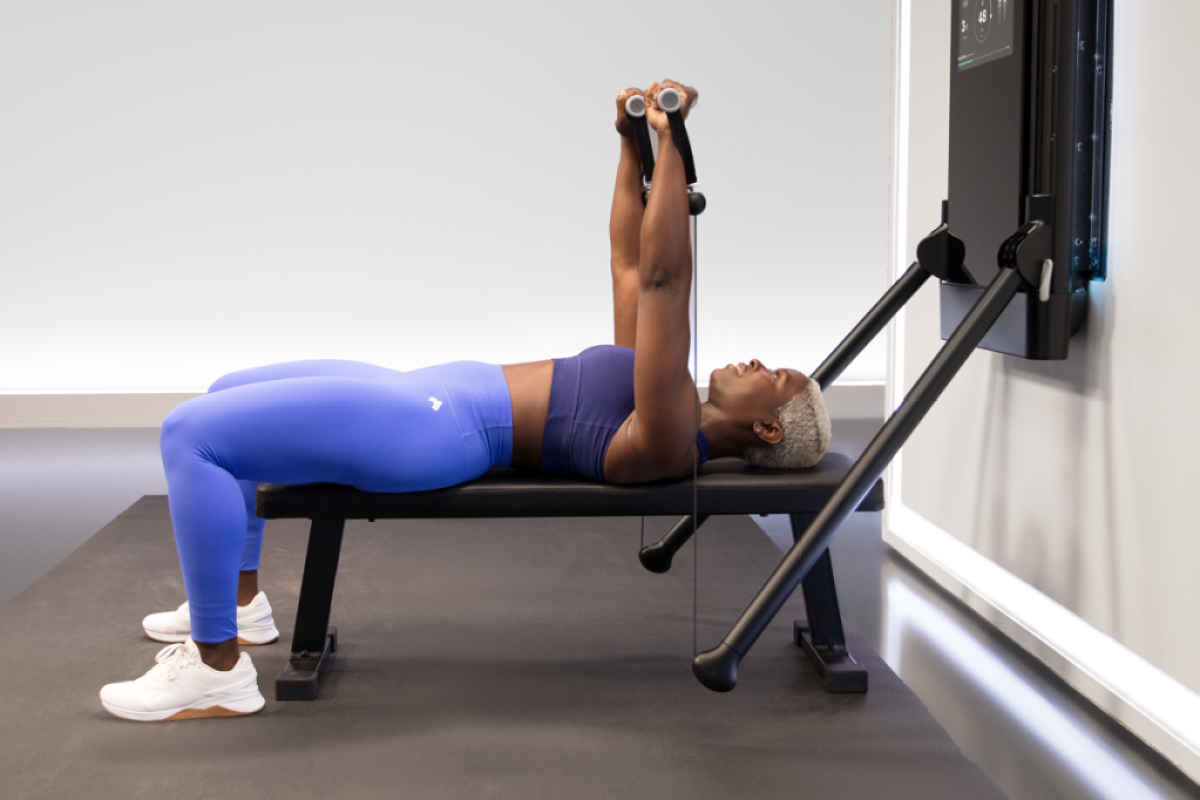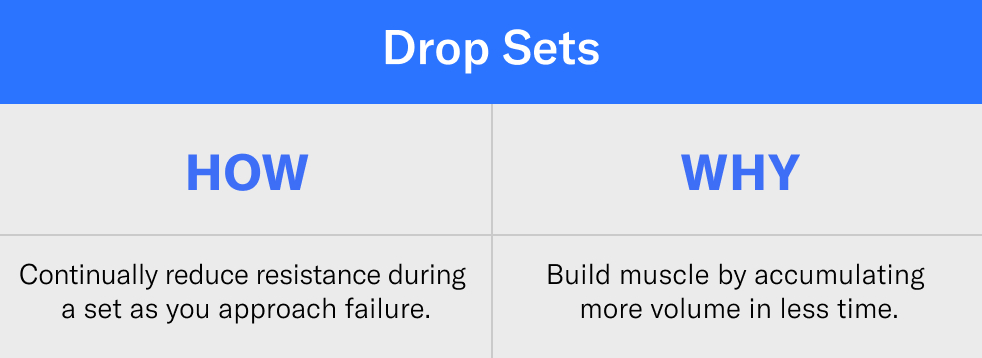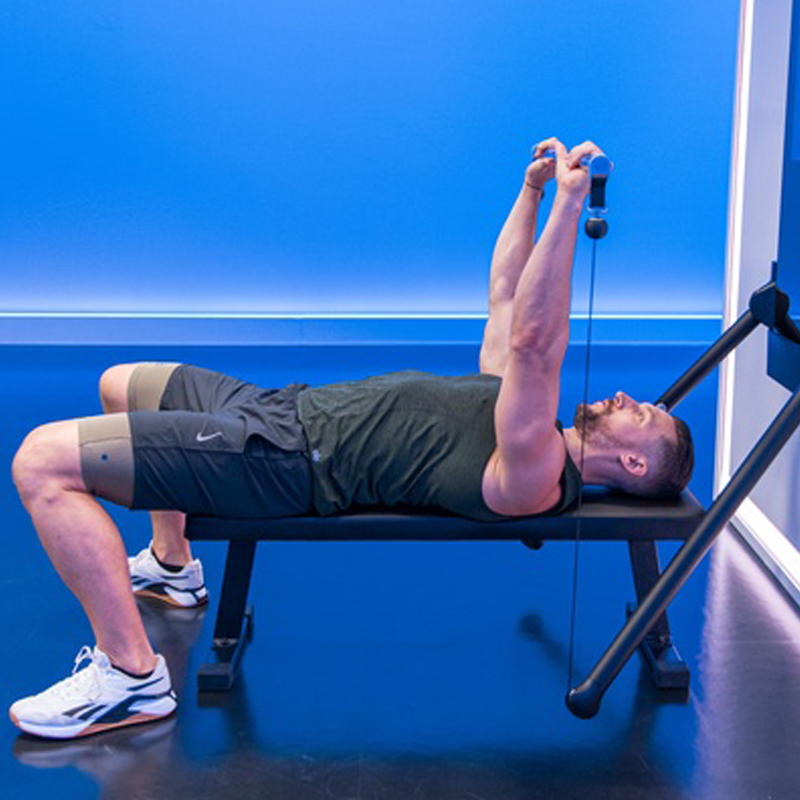Save Time, Build Muscle, and Increase Total Volume with Drop Sets
This muscle-burning technique is one of the most efficient ways to bang out more reps.

You’re pushing through a set of chest presses and you barely make it through. The next 10 reps you had planned seem impossible without a decently long rest—maybe even a lunch break? Rather than bailing on your workout altogether, you decide to drop the load for your next few reps. You fight through another couple of reps, successfully riding the edge of failure, and drop the load again so you can keep your form on point while challenging your muscles to keep cranking.
If any of that sounds familiar, congratulations: you’ve successfully completed a drop set. Not only are drop sets considered an advanced muscle-building technique, but they can also allow you to cut down on the length of your training sessions without sacrificing your gains.
What Are Drop Sets?
Drop sets are a strength training technique that involves pushing your muscles to the limit within a set, and then gradually lightening your load as the set goes on. Using drop sets allows you to reduce the load within each set so that you can keep pushing, allowing you to eke out more reps near failure in less time.
“The benefit of drop sets is that they’re time efficient. You can increase the volume within a session, but save time without extra sets and rest periods,” says Jacob Rauch, CSCS, PhD candidate, and performance manager of applied training science at Tonal.
On Tonal, you might already be familiar with drop sets thanks to Burnout mode, which automatically reduces the weight and continues to reduce it if you keep getting stuck. The goal, however, is to keep repping it out until the set is over.
What Are The Benefits of Drop Sets?
Drop sets are a great way to achieve hypertrophy, or muscle growth. While there are many different techniques that stimulate hypertrophy, the underlying principle across these methods is to progressively overload your body with intentional, safe amounts of stress. That usually means gradually increasing your intensity with increased resistance/weight, volume, frequency, or density (meaning longer work intervals and shorter rest intervals). But according to Rauch, one of these factors takes precedence over the others when it comes to gaining muscle mass.
“The most important training variable for muscle hypertrophy is volume, which can be defined as sets performed per muscle group per week,” Rauch says. He explains that there is a dose-response relationship between training volume and muscle growth, meaning the more volume you lift in a set period of time, the more your muscles will grow.
“For trained individuals, it’s currently recommended they perform 10-20 sets per muscle group per week,” he says. “As such, trained individuals, in particular, are always searching for ways to increase their session volume load — and drop sets can do just that.” This is only a general guideline though as the upper limits of this dose-response relationship are still being explored and individuals will likely have different thresholds.

As Rauch explains, “When you’re time-pressed, drop sets can be a great way to increase total training volume, bring select sets to failure at the end of a workout, or stand on their own to enable you to get the biggest bang for your buck.”
The reason drop sets can be so effective is the fact that you can generally crank out more reps in a shorter period of time, and a majority of those reps are going to be in fatigued states which may increase motor unit recruitment and be favorable for hypertrophy. In drop sets, you have multiple opportunities to hit muscular failure, once for each drop in weight, so you’re working close to failure for more of your reps.
However, Rauch explains that there is still some debate about whether training to muscular failure is necessary for muscle growth. “The often-referenced downside of training to failure is that it can result in fatigue,” he says, which can affect your performance through the remainder of your workout. Rauch suggests training to failure toward the end of a workout session or only on single joint exercises where there’s a lower injury risk if your technique breaks down.
The upside to training to muscle failure is rooted in a concept called Henneman’s size principle, which states that your body recruits motor units (i.e. your motor neurons and muscle fibers) in order of size, from smallest to biggest, depending on intensity. “When training with moderate loads, low-threshold motor units are recruited early on,” Rauch says. “However, as the set progresses, these motor units fatigue and activate the higher threshold motor units which have a greater capacity to hypertrophy. As such, training to failure is thought to be necessary to recruit all possible motor units.”
How Drop Sets Can Help You Build Strength
There are a lot of options for how to incorporate drop sets into your routine to make them work for you. “Whether its purpose is to boost training volume or ensure the activation of all available motor units, drop sets can seamlessly be integrated into the end of sessions without compromising the overall session volume,” Rauch says. “Drop sets are an enjoyable and smooth experience that maximize hypertrophic potential.”
In addition to increasing your volume within a traditional workout structure, Rauch says it’s also possible to center an entire workout around drop sets, which calls on a principle known as the minimal effective dose, or the least amount of exercise necessary to get a positive result.
Besides stimulating muscle growth, drop sets may also increase strength or the maximum amount of resistance you can lift. A recent meta-analysis found that performing a single set to failure two to three times per week produces significant increases in lower body strength, but lesser gains than doing multiple sets, in resistance-trained males. Therefore, if you don’t have the time to perform a complete workout but still want to give yourself a stimulus, a single set to failure or a drop set could be a great way to maintain and potentially even improve your strength.
In a holistic training program, you’re going to want to tick off the most important boxes: training with sufficient volume to stimulate hypertrophy and sufficient load to stimulate strength gains. Drop sets can complement both of these goals by increasing the total volume load of a traditional session or by serving as a stand-alone workout on a day when you are pressed for time.
Drop Set Workouts on Tonal
Give drop sets a try on Tonal with one of these expertly-designed sessions. You’ll often see Burnout mode activated in high-volume or long-duration sets to automatically reduce the resistance as you approach failure.
Drop Set Strength – Coach Joe Rodonis

In this advanced, muscle-building program you’ll use drop sets to push your limits and accelerate full-body gains.
Chiseled to the Core – Multiple Coaches

Gain muscle while burning fat in this high-intensity program. You’ll get in high-volume mechanical drop sets, progressing from a heavy lift to a bodyweight move to burn out your working muscles.
Tag Team: Drop Sets and Sweat – Coach Tim Landicho and Coach Tanysha Renee

Duration-based drop sets are used in this workout to both build muscle and get your heart rate up. The addition of metabolic moves and core exercises makes for a well-rounded session.


